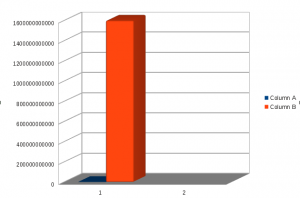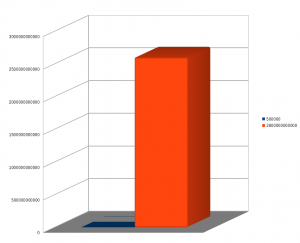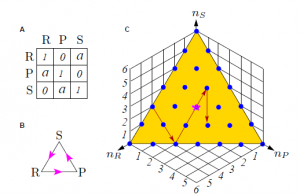The 50 Most Innovative Computer Science Departments in the U.S. by Yusuf Laher.
A great resource but the additional links were written as text and not hyperlinks. Thus, for University of Texas at Austin:

Compare my listing (which included links buried in prose):
11. Department of Computer Science, University of Texas at Austin – Austin, Texas
Department of Computer Science
https://www.cs.utexas.edu/faculty
https://www.cs.utexas.edu/about-us
I deleted the prose descriptions, changed all the links into HTML links, swept for vanity links, such as prior rankings, etc. What’s left should be links to the departments, major projects and faculty. It’s a rough cut but suitable for spidering, etc.
50. Department of Computer Science, University of Arkansas at Little Rock – Little Rock, Arkansas
Department of Computer Science
http://ualr.edu/eit/
http://ualr.edu/computerscience/prospective-students/facilities/
49. School of Informatics and Computing, Indiana University – Bloomington, Indiana
School of Informatics and Computing
Student Technology Centers
http://www.soic.indiana.edu/faculty-research/
http://www.soic.indiana.edu/about/
48. Department of Computer Science & Engineering, Texas A&M University – College Station, Texas
Department of Computer Science & Engineering
the High Performance Computing Laboratory
http://engineering.tamu.edu/cse/
47. School of Computing, Informatics and Decision Systems Engineering, Arizona State University – Tempe, Arizona
School of Computing, Informatics and Decision Systems Engineering
Center for Excellence in Logistics and Distribution
http://cidse.engineering.asu.edu/facultyandresearc/research-centers/
46. Department of Computer Science, The University of North Carolina at Chapel Hill – Chapel Hill, North Carolina
Department of Computer Science
https://www.cs.unc.edu/cms/research/research-laboratories
45. Department of Computer Science, Rutgers University – Piscataway, New Jersey
Department of Computer Science
Hack R Space
44. Department of Computer Science, Stony Brook University – Stony Brook, New York
Stony Brook University
Center of Excellence in Wireless and Information Technology
https://www.cs.stonybrook.edu/research
43. Department of Computer Science & Engineering, Washington University in St. Louis – St. Louis, Missouri
Department of Computer Science & Engineering
Cyber-Physical Systems Lab
Stream-based Supercomputing Lab
http://cse.wustl.edu/aboutthedepartment/Pages/history.aspx
http://cse.wustl.edu/Research/
42. Department of Computer Science, Purdue University – West Lafayette, Indiana
Department of Computer Science
Center for Integrated Systems in Aerospace
https://www.cs.purdue.edu/research/centers.html
http://www.purdue.edu/discoverypark/cri/research/projects.php
41. Computer Science Department, New York University – New York City, New York
Computer Science Department
40. Electrical Engineering and Computer Science, Northwestern University – Evanston, Illinois
Electrical Engineering and Computer Science department
http://eecs.northwestern.edu/2013-09-03-20-01-56/researchgroupsandlabs/
http://www.eecs.northwestern.edu/graduate-study
39. School of Computing, The University of Utah – Salt Lake City, Utah
School of Computing
Scientific Computing and Imaging Institute
http://www.cs.utah.edu/research/
http://www.cs.utah.edu/about/history/
38. Department of Computer Science, University of California, Santa Barbara – Santa Barbara, California
Department of Computer Science
Four Eyes Lab
https://www.cs.ucsb.edu/research
37. Department of Computer Science and Engineering, University of Minnesota – Minneapolis, Minnesota
Department of Computer Science and Engineering
Laboratory for Computational Science and Engineering
http://www.cs.umn.edu/department/excellence.php
http://www.cs.umn.edu/research/
36. Department of Computer Science, Dartmouth College – Hanover, New Hampshire
Department of Computer Science
Visual Learning Group
computational biology-focused Grigoryan Lab
http://web.cs.dartmouth.edu/research/projects
35. Department of Computer Science and Engineering, The Ohio State University – Columbus, Ohio
computer science programs
https://cse.osu.edu/research
34. Department of Computer Science, North Carolina State University – Raleigh, North Carolina
Department of Computer Science
Visual Experiences Lab
http://www.csc.ncsu.edu/news/
33. Computer Science Department, Boston University – Boston, Massachusetts
Computer Science Department
http://www.bu.edu/hic/about-hic/
32. Department of Computer Science, University of Pittsburgh – Pittsburgh, Pennsylvania
Department of Computer Science
Pittsburgh Supercomputing Center
http://www.cs.pitt.edu/research/
31. Department of Computer Science, Virginia Polytechnic Institute and State University – Blacksburg, Virginia
computer science programs
30. Department of Computer Science, University of California, Davis – Davis, California
Department of Computer Science
http://www.cs.ucdavis.edu/index.html
http://www.cs.ucdavis.edu/research/index.html
http://www.cs.ucdavis.edu/iap/index.html
29. Department of Computer Science and Engineering, Pennsylvania State University – University Park, Pennsylvania
Department of Computer Science and Engineering
Institute for CyberScience
https://www.cse.psu.edu/research
http://ics.psu.edu/what-we-do/
28. Department of Computer Science, Johns Hopkins University – Baltimore, Maryland
Department of Computer Science
boundary-crossing areas
Center for Encrypted Functionalities
http://www.cs.jhu.edu/research/
27. School of Computer Science, University of Massachusetts Amherst – Amherst, Massachusetts
School of Computer Science
https://www.cs.umass.edu/faculty/
26. Department of Computer Science, University of Illinois at Chicago – Chicago, Illinois
Department of Computer Science
25. Rice University Computer Science, Rice University – Houston, Texas
computer science department
24. Department of Computer Science, Donald Bren School of Information and Computer Sciences, University of California, Irvine – Irvine, California
Donald Bren School of Information and Computer Sciences
Center for Emergency Response Technologies
Center for Machine Learning and Intelligent Systems
Institute for Virtual Environments and Computer Games
http://uci.edu/academics/ics.php
http://www.ics.uci.edu/faculty/
23. Department of Computer Science, University of Maryland – College Park, Maryland
Department of Computer Science
Institute for Advanced Computer Studies
https://www.cs.umd.edu/research
22. Brown Computer Science, Brown University – Providence, Rhode Island
computer science department
Center for Computational Molecular Biology
Center for Vision Research
http://cs.brown.edu/research/
21. Department of Computer Science, University of Chicago – Chicago, Illinois
Department of Computer Science
http://www.cs.uchicago.edu/research/labs
20. Department of Computer and Information Science, University of Pennsylvania – Philadelphia, Pennsylvania
Department of Computer and Information Science
Electronic Numerical Integrator and Computer
http://www.seas.upenn.edu/about-seas/eniac/
19. Department of Computer Science and Engineering, University of California, San Diego – La Jolla, California
Department of Computer Science and Engineering
18. Department of Computer Science, University of Southern California – Los Angeles, California
Department of Computer Science
http://www.cs.usc.edu/research/centers-and-institutes.htm
17. Department of Electrical Engineering and Computer Science, University of Michigan – Ann Arbor, Michigan
Department of Electrical Engineering and Computer Science
http://www.eecs.umich.edu/eecs/research/reslabs.html
16. Department of Computer Sciences, University of Wisconsin-Madison – Madison, Wisconsin
Department of Computer Sciences
https://www.cs.wisc.edu/people/emeritus-faculty
15. College of Computing, Georgia Institute of Technology – Atlanta, Georgia
College of Computing
Center for Robotics and Intelligent Machines
Georgia Tech Information Security Center
http://www.cse.gatech.edu/research
14. Department of Computer Science, Yale University – New Haven, Connecticut
Department of Computer Science
http://cpsc.yale.edu/our-research
13. Department of Computing + Mathematical Sciences, California Institute of Technology – Pasadena, California
Department of Computing + Mathematical Sciences
Annenberg Center
http://www.cms.caltech.edu/research/
12. Department of Computer Science, University of Illinois at Urbana-Champaign – Urbana, Illinois
Department of Computer Science
http://cs.illinois.edu/research/research-centers
11. Department of Computer Science, University of Texas at Austin – Austin, Texas
Department of Computer Science
https://www.cs.utexas.edu/faculty
10. Department of Computer Science, Cornell University – Ithaca, New York
Department of Computer Science
Juris Hartmanis
http://www.cs.cornell.edu/research
http://www.cs.cornell.edu/people/faculty
9. UCLA Computer Science Department, University of California, Los Angeles – Los Angeles, California
Computer Science Department
http://www.cs.ucla.edu/people/faculty
http://www.cs.ucla.edu/research/research-labs
8. Department of Computer Science, Princeton University – Princeton, New Jersey
computer science department
http://www.cs.princeton.edu/research/areas
7. Computer Science Division, University of California, Berkeley – Berkeley, California
Computer Science Division
6. Harvard School of Engineering and Applied Sciences, Harvard University – Cambridge, Massachusetts
School of Engineering and Applied Sciences
http://www.seas.harvard.edu/faculty-research/
5. Carnegie Mellon School of Computer Science, Carnegie Mellon University – Pittsburgh, Pennsylvania
School of Computer Science
http://www.cs.cmu.edu/directory/
4. Computer Science & Engineering, University of Washington – Seattle, Washington
Computer Science & Engineering
Paul G. Allen Center for Computer Science & Engineering
https://www.cs.washington.edu/research/
3. Department of Computer Science, Columbia University – New York City, New York
The Fu Foundation School of Engineering and Applied Science
http://engineering.columbia.edu/graduateprograms/
http://www.cs.columbia.edu/people/faculty
2. Computer Science Department, Stanford University – Stanford, California
Computer Science Department
http://www-cs.stanford.edu/research/
1. MIT Electrical Engineering & Computer Science, Massachusetts Institute of Technology – Cambridge, Massachusetts
Electrical Engineering & Computer Science
Computer Science and Artificial Intelligence Laboratory
Suggestions for further uses of this listing welcome! (Or grab a copy and use it yourself. Please send a link to what you make out of it. Thanks!)
 Or at least they shouldn’t have that kind of access.
Or at least they shouldn’t have that kind of access.





